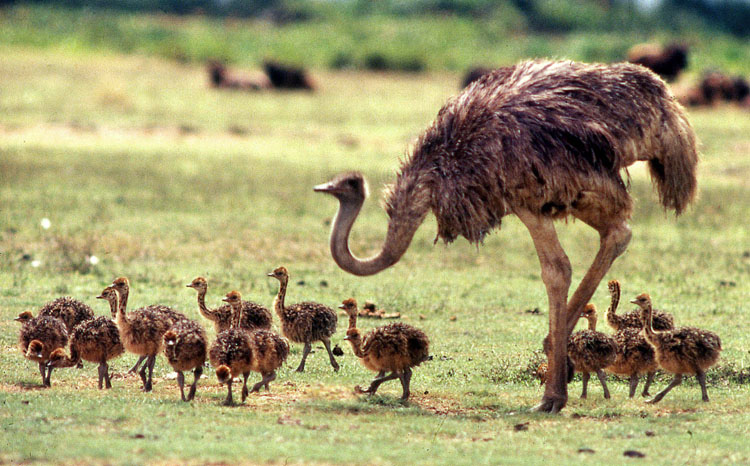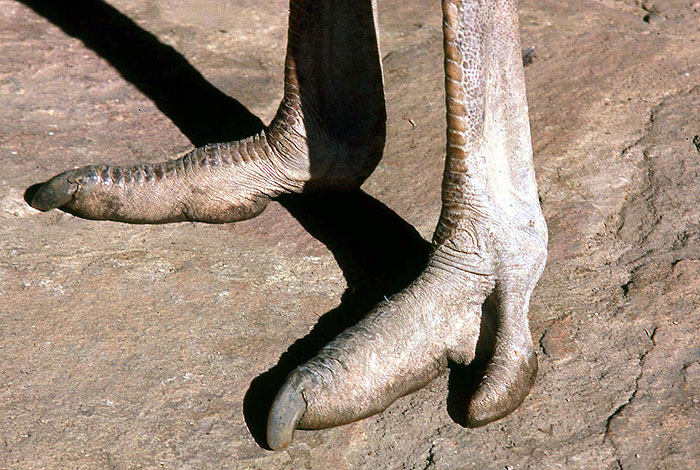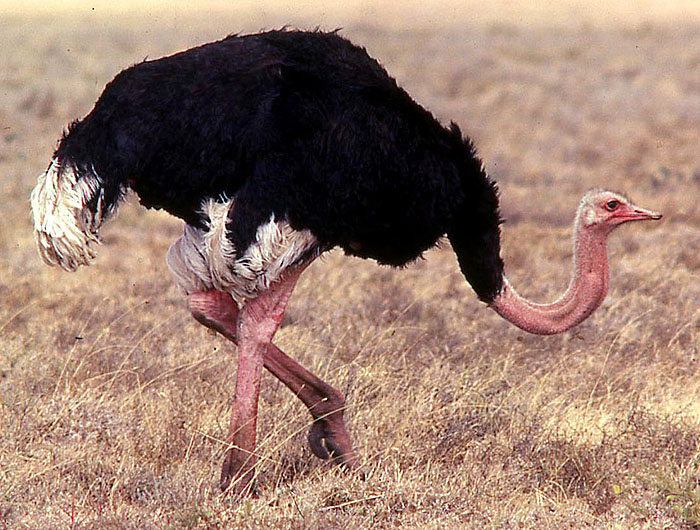Confessions of an Ostrich
Hi there! My name is Daneka, and I am an ostrich. I don't live in a zoo, or on a farm like a lot of ostriches do, I live in a desert in Central Africa with other ostriches. You may wonder, how is it possible for us ostriches to survive in such a hot, dry climate? Well, let me tell you. We retain water from all the plants we eat and our eyes are protected from desert sand storms by our thick eyelashes. As well, we have a special transparent eyelid-like membrane that protects our eyes from the harsh environment while allowing us to see. I, like most ostriches, am very capable of protecting myself against predators in the desert because even though I can't fly, I can run up to seventy kilometers per hour. Pretty speedy, eh? I mean, one of my strides can be three to five metres long! My fast running allows me to outrun most predators. Even if a predator can catch up with me, I can kick at them with my very strong and powerful feet, which they definately won't be a match for. You can see what I mean down below, our claws are pretty powerful!
I bet you've seen lots of pictures of ostriches that all look different, right? Well that's because female and male ostriches have different and similar characteristics. Our height can reach up to 2.6m, and our weight up to 136 kg. We are the largest type of bird in the world. We have small flat heads that, along with our necks, are covered with soft downy feathers- not like the normal smooth, water-resilient feathers a lot of birds have. Along with that difference, we are the only kind of birds to have two toes on each foot. The plumage of male ostriches is glossy black, with white wings and tail feathers, while the plumage of females, like me, and young male ostriches is greyish brown. I bet you wonder why we have wings but we don't use them to fly? Well, we use our wings to help us balance when running, and for displays. Male ostriches also use their wings for courtship displays.
Lately, I've been really busy raising all my chicks that you can see up at the top in that photo. I'm just so proud of all of them, they're growing up so fast. Let me tell you how they came to be. It all started when the mating season began. During the mating season, all ostriches break up into groups of one male and two to four females. The male, in this case my friend Kapar, will perform a series of wing flapping, hissing, and stomping. If he impresses us (and boy did he ever!) we will mate. The male ostrich in the group then selects a nesting sight by scraping a slight indentation in the sand or soil. This is where I, the dominant female of my group, lay my eggs first, then the other females of the group lay theirs. There can be up to sixty eggs laid in total, and almost half of them are laid by me, the dominant female. The eggs then need to be incubated and turned over regularly over a period of six weeks. Me and Kapar were in charge of this. We took turns, I nurtured the eggs during the day and he took good care of them at night. After six weeks of incubation, the eggs hatch! It is so exciting when our chicks are finally born, all the ostriches in each group tend to the chicks until they are able to feed themselves. Sadly, not all the chicks will make it because some sneaky predator might have taken them away or the egg just didn't fully mature. The ones that do make it are very cherished and prized by the whole group of us. We don't end up leaving them on their own until they can eat by themselves. We usually protect our chicks for about three years until they mature into adults.
These are my true confessions, and I'm glad you stopped by to check them out! I hope you learned something valuable from my story and feel the urge to find out more about me and my family. Go ahead and check out the links below because they are truly fascinating!
Love,
Daneka
Information on the Internet
- Ostrich A brief explanation of the physical and behavioural characteristics of the ostrich.
- Ostrich A more fun filled learning experience with interesting facts.
- Ostrich Fast, fascinating facts- good for general knowledge.
- Ostrich Birds General information along with many exciting pictures!
- Ostrich Information A little more advanced information but lots of cool pictures.







 Go to quick links
Go to quick search
Go to navigation for this section of the ToL site
Go to detailed links for the ToL site
Go to quick links
Go to quick search
Go to navigation for this section of the ToL site
Go to detailed links for the ToL site